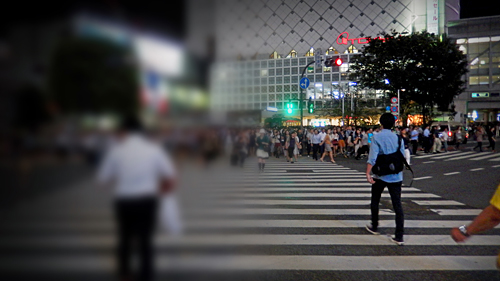This post is also available in Dutch.
Imagine that you are not conscious of one half of the world around you. That you don’t notice someone sitting on your left in the train, for example. Maybe this is difficult to imagine. Yet patients with hemispatial neglect are living in such a world. How can we treat this extraordinary disorder?

“Half” of the busy area Shibuya, Tokyo, Japan. Photo by Angelique Tinga.
Hemispatial neglect (in short, “neglect”) occurs in about half of people that have recently suffered from stroke. Often, patients with hemispatial neglect have brain damage in one side of the brain, in an area important to attention regulation. As a consequence, they have problems with consciously perceiving one half of the outside world or one half of their body. The right side of the brain is commonly damaged in patients with neglect, and, as a result, these patients can walk into something on the left, or can “forget about” a left body part.
Thus, neglect can cause serious problems. Because these problems can also hamper recovery after stroke, it is of utmost importance that the disorder is treated right.
Training visual attention
A common rehabilitation method for neglect is visual scanning therapy, during which patients practice focusing visual attention on the affected side with the help a therapist’s specific feedback. A downside of this therapy is that it is time-consuming. In addition, it improves the trained visual attention, but it does not improve non-trained aspects (such as spatial perception). For this reason, other rehabilitation options are being examined.
Influencing brain activity
A novel line of research focuses on influencing brain activity as a potential rehabilitation method. Brain activity is influenced by applying weak magnetic or electric pulses to the outside of the skull. These techniques, transcranial magnetic stimulation (TMS) and transcranial direct current stimulation (tDCS), are safe and utilized frequently in research. The applied pulses can increase the activity in the affected half of the brain or lower the activity in the unaffected half. The idea behind this approach is that attention can be better focussed on the affected side.
Stimulating the senses
Another novel technique that could be interesting for rehabilitation is multisensory stimulation. In this technique at least two different senses are stimulated, such as sight and hearing. For example, patients could look at a dot while listening to a matching tone. The combination of two sensory stimuli could lead to increased brain activity, which increases the chance of conscious perception.
The novel techniques discussed are promising for rehabilitation of neglect. Yet further research is necessary before they can be applied as an effective intervention. The search for how the world of patients with neglect can be made “complete” again has not yet ended.
More information:
Hemispatial neglect
Innovative rehabilitation techniques for hemispatial neglect
Multisensory stimulation after stroke
